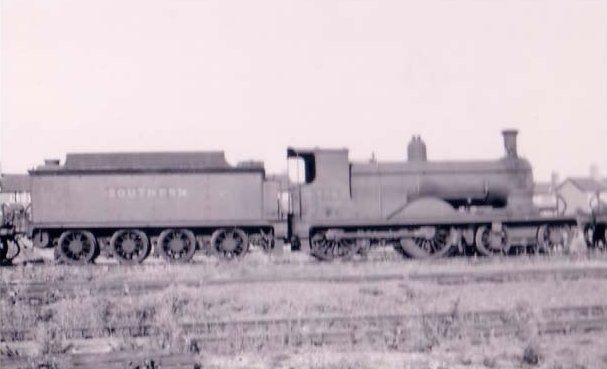- LSWR K10 class
Infobox Locomotive
powertype=Steam
name = LSWR/SR K10 Bradley, D. L.: "An illustrated history of LSWR Locomotives: the Drummond Classes" (Didcot: Wild Swan Publications, 1986) ISBN 0906867428 ]
caption = K10 number 386 at Eastleigh, 1950
designer =Dugald Drummond
builder = LSWR Nine Elms Works
builddate = 1901-1902
totalproduction = 40
whytetype = 4-4-0
gauge = RailGauge|ussg
leadingsize = 3 ft 7 in (1.12 m)
driversize = 5ft 7in (1.7 m)
length = ft in ( m)
weight = 46 tons 14 cwt (47.4 tonnes)
fueltype = coal
fuelc
waterc3)
cylindercount = 2
cylindersize = 18.5in x 26in (470mm × 660mm)
boilerpressure = lbf/in² ( kPa)
tractiveeffort = lbf ( kN)
railroad=London and South Western Railway ,Southern Railway (Great Britain) ,Southern Region of British Railways
locale=Great Britain
railroadclass=|The
London and South Western Railway K10 Class was a class of 404-4-0 steam locomotive s designed for mixed traffic work. They were introduced on theLondon and South Western Railway in1901 and1902 to the design ofDugald Drummond , where they earned the nickname "Small Hoppers".Background
In order to satisfy a pressing requirement for mixed-traffic locomotives, Drummond adopted the solution of a small-wheeled 4-4-0 he had previously employed on the
Caledonian Railway . The resulting K10 had the same 5' 7" diameter coupled wheels as the M7 and the boiler was interchangeable with the M7, 700 and C8 classes [Casserley, H.C. :"London and South Western locomotives", incorporating Burtt, F.: "LSWR locomotives- a survey." (published 1949) (Ian Allan, Shepperto, UK, enlarged ed. 1971) pp.125, 126]Construction history
40 of the class were subsequently outshopped from the LSWR's Nine Elms locomotive works. They were generally paired with a 6-wheel tender because of their intended short journey lengths, which included local stopping trains and medium-level freight haulage, but as with the later L11 class, some could occasionally be seen with a 4000 gallon "watercart" tender for longer trips.
Livery and numbering
LSWR and Southern
Livery under the LSWR was Drummond's LSWR Passenger Sage Green, with purple-brown edging and black and white lining. Swift, Peter: "Maunsell 4-6-0 King Arthur Class" (Locomotives in Detail series volume 4) (Hinckley: Ian Allan Publishing, 2006), ISBN 0711030863 ] Under Southern Railway ownership from grouping in 1923, the locomotives were outshopped in
Richard Maunsell 's darker version of the LSWR Sage Green with yellow lettering on the tender, with black and white lining.This livery was continued under Bulleid despite his experimentations with Malachite Green, though the 'Southern' lettering on the tender was changed to the 'Sunshine Yellow' style. During the
Second World War , members of the class outshopped form overhaul were turned out in wartime black.The class was haphazardly numbered by the LSWR. Numbering under the Southern retained the LSWR allocations. Bradley, D. L.: "An illustrated history of LSWR Locomotives: the Drummond Classes" (Didcot: Wild Swan Publications, 1986) ISBN 0906867428 ]
Post-1948 (nationalisation)
Livery after Nationalisation was initially Southern livery with 'British Railways' on the tender, and an 'S' prefix on the number. The class was subsequently outshopped in BR Mixed Traffic Black with red and white lining, with the BR crest on the tender. Longworth, Hugh: "British Railway Steam Locomotives: 1948-1968" (Oxford: Oxford Publishing Company, 2005) ISBN 0860935930]
Locomotive numbering was per BR standard practice, from 30135 to 30153 and 30329 to 30394. However, thirteen of the locomotives had been withdrawn by the end of 1948, resulting in gaps in the sequence. Longworth, Hugh: "British Railway Steam Locomotives: 1948-1968" (Oxford Publishing Company: Oxford, 2005) ISBN 0860935930]
Operational details
The class shared the same inability to sustain their power over long distances as the C8s, leading to the K10s being employed only on occasional main line trips over short distances. The class therefore gained the nickname of "Small Hoppers" from their crews. The aforementioned defect was not a hindrance, with the class leading an admirable career on secondary routes. Due to the LSWR being primarilly a passenger railway, there were few heavy goods services that would have proved too much for the design despite its flaws.
Twenty-three passed into
British Railways ownership in 1948. None has survived to be preserved.References
Further reading
* Ian Allan ABC of British Railways Locomotives, 1949 edition, part 2
External links
* [http://www.semgonline.com/steam/k10class_01.html SEMG gallery]
Wikimedia Foundation. 2010.

)